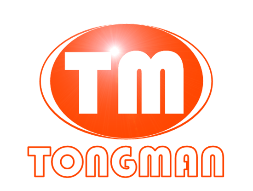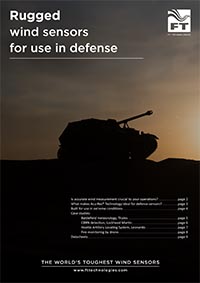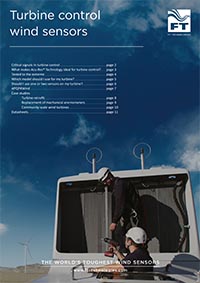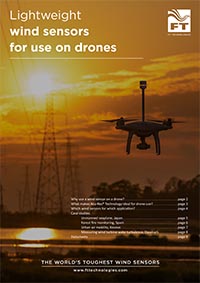Peak Conditions
The freezing conditions at the summit of Mount Washington make it the perfect setting for wind sensor data tests.
Where do you go if you want to put ‘the world’s toughest wind sensors’ to the test? How do you prove your claim that your wind sensors will withstand the harshest environments that the planet can offer? FT Technologies, manufacturer of the FT7 Series of ultrasonic wind sensors, chose Mount Washington Observatory on the summit of Mount Washington in New Hampshire, USA.
The World’s Worst Weather
At 1,917m (6,288ft), Mount Washington Observatory is one of only a handful of permanently staffed mountaintop weather stations in the world. The self-styled ‘Home Of The World’s Worst Weather’ boasts an environment on a par with the polar regions, but offers readily accessible and consistently extreme conditions, with an average winter temperature of -14°C (6.8°F), and a record low of -44°C (-47.2°F), combined with an annual average windspeed of 16m/s (or 20m/s in winter). The summit’s distinctive feature is this combination of Arctic temperatures, high winds and high precipitation – an average of nearly 25cm (9.84in) in October and November. Mount Washington provides a challenging test environment that is impossible to reproduce in a lab.
Its freezing temperatures, moisture and high winds made it the perfect place in which to test the data availability of several different types of wind sensor. These hostile conditions can prove catastrophic to electronic precision instruments. To survive and to function, there must be adequate measures to oppose the effects of the cold. Even Mount Washington Observatory’s permanently sited pitot tube, which has 1,500W of heating, occasionally stops working due to components icing up.
FT ran tests in an icing wind tunnel to identify how much icing the sensor could resist and what power would be required to keep it ice-free. This two-part test was in accordance with US MIL-STD 810G. The first part is a de-icing test, where 45mm of ice is allowed to build up on the sensor. The sensor is then powered and must be able to de-ice itself within 15 minutes, at an ambient temperature of -14°C (6.8°F), which it did.
The second part involves spraying the sensor with water while it is powered in a 15m/s airflow at -14°C (6.8°F), until 37mm (1.46in) of ice has built up on a nearby test bar. Testing showed that with the sensor drawing 210W of power, an FT7 Series sensor could stay ice-free in an effective wind chill of -27.6°C (-17.7°F). Further testing was performed in the same icing wind tunnel with the sensor drawing only 96W of power. The sensor managed to stay ice-free down to -5°C (23°F) in 15m/s airflow, while being sprayed with water, equivalent to -15°C (5°F) wind chill.
Wind Sensors On Trial
FT Technologies ran the Mount Washington test from March to May 2017. Observatory staff erected two FT742-DM acoustic resonance wind sensors at the weather station – one was set to draw 216W of power and the other, 288W. There was also an unheated mechanical sensor designed for icing environments and another heated ultrasonic sensor set to draw 240W. Data availability and general performance was datalogged using a Campbell CR6 datalogger and the data was regularly downloaded by FT engineers in the UK. Ultrasonic wind sensors have no moving parts. Mechanical anemometers are especially vulnerable to icing conditions, which increase mass on the cups (leading to inaccurate windspeed measurements) before freezing up. Maintaining ice-free performance requires effective heating to prevent ice build-up around and on the sensor. Consequently, the materials used to construct the sensor must be carefully chosen and the sensor well designed, to ensure that heat flows evenly over the surface of the sensor and into the mounting system. In some circumstances the sensor itself can be ice-free but still blinded by ice accumulating on the mounting.
Highest Data Availability
The lowest temperature recorded during the test was -25.9°C (-14.6°F) with a coincidental windspeed of 40.6m/s. At one point, glaze ice was forming at a rate of 12cm (4.7in) per hour in -50.9°C (-59.6°F) wind chill. Many days had sub-zero temperatures, high windspeed, cloud, heavy precipitation and freezing fog.
The ultrasonic sensors (unlike mechanical sensors) can assess the quality of the data they produce and output messages if the data is of poor quality. The FT engineers looked at the incidence of this data on an ongoing basis to determine the overall data availability over the 77 days of the test. The FT sensor running at 288W showed 97.97% data availability – higher than the other sensors – and kept itself ice-free for 73.65 days. Each icing event lasted on average just under 15 seconds, so the sensor was able to quickly de-ice itself and continue delivering data.
Fred Squire, FT’s director of sales and marketing, said of the test results, “We are delighted. The FT sensors showed the highest data availability of those tested. If our sensors can survive on Mount Washington, they can survive anywhere.” Detailed analysis of the data is continuing and while the lab results showed that the sensor could stay ice free in a water stream at a wind chill of -27.9C (-18.2°F), at Mount Washington, icing events were occurring at wind chills in the low -20s centigrade, proving the usefulness of real world testing.
World’s Most Tested
It’s not only cold temperatures and ice that pose a threat to wind sensors. Heat, lightning, heavy rain, sand and solar radiation can also interfere with their smooth functioning. When used in marine applications, wind sensors are vulnerable to corrosion and even bird attack.
FT Technologies sensors undergo independent laboratory tests for shock, hail, vibration, corrosion, altitude and lightning protection. They were recently submitted to a series of ingress protection tests designed to simulate what happens to a sensor in heavy rain driven by a typhoon or hurricane.
First, the sensors were sprayed with dust for two hours. They were then sprayed by powerful water jets at a flow rate of 100 l/min (26.42gpm), from a distance of 2.5m (8.2ft), for three minutes each time. They were also immersed in 1m (3.3ft) of water for 30 minutes. These tests showed that the sensors are dust- and water-tight and that they met IP66 and IP67 ingress protection standards.
“The FT7 Series are probably the most tested wind sensors in the world,” said Squire. “They have passed over 28 independent tests and our own highly accelerated lifecycle test (HALT) in which they are temperature cycled from 125°C (257°F) to -90°C (-130°F) while being vibrated at 50Grms.
“Our wind sensors are 100% wind tunnel checked before despatch, to ensure that they will give many years of reliable service, even in the harshest conditions. The wind tunnel is calibrated annually and sensors are regularly selected from production and their calibration cross-checked in a MEASNET wind tunnel. This ensures their accuracy.”
Winter Testing In Canada
This wasn’t the first time that FT had subjected its sensors to this type of winter testing. In 2013, it worked with the TechnoCentre Éolien in Gaspé, Canada, which helps businesses test and adapt technology to the hostile northern climate.
The test site, near Rivière-au-Renard, Quebec, is coastal, with mountainous topography. Two heated FT702LT wind sensors were installed on a 126m (413ft) mast, at 84m (276ft) and 122m (400ft)above ground level. The test ran from January until May, with performance comparisons provided by unheated and heated mechanical cup anemometers in addition to a conventional time-of-flight ultrasonic wind sensor.
Over the test period, nine heavy icing events were reported at the meteorology mast. The lowest recorded temperature was -26.2°C (-15.2°F), with a total of 10 days below -20°C (-4°F). The maximum windspeed during the test was 30.3m/s. The FT sensors remained ice-free during the tests. The heated and unheated cup anemometers experienced icing rates of 3.4% and 13.8% respectively and the time-of-flight ultrasonic wind sensor was destroyed by an ice impact after 30 days in operation.
The TechnoCentre Éolien reported that both FT Technologies FT702LT sensors achieved more than 99.9% data availability.
